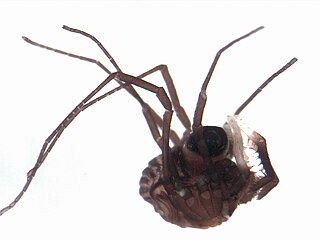
The Opiliones are an order of arachnids colloquially known as harvestmen, harvesters, harvest spiders, or daddy longlegs. As of April 2017, over 6,650 species of harvestmen have been discovered worldwide, although the total number of extant species may exceed 10,000. The order Opiliones includes five suborders: Cyphophthalmi, Eupnoi, Dyspnoi, Laniatores, and Tetrophthalmi, which were named in 2014.

Cosmetidae is a family of harvestmen in the suborder Laniatores. With over 700 species, it is one of the largest families in Opiliones. They are endemic of the New World with a Nearctic-Neotropical distribution where a large fraction of the diversity of Opiliones are represented by this single family. Cosmetidae have the northern extent of their range into the USA, where a small number species occur in the southern states. However, the family is especially diverse in Mexico, Central America and northern South America; especially the Andean realms. Their range also extends further south into Argentina and southern Brazil, but they are absent in Chile. Cosmetidae are prevalent in Amazonian region, but only relatively few also occur in Brazilian Atlantic Forest. Several species are also found in the Caribbean.

Dyspnoi is a suborder of harvestmen, currently comprising 43 extant genera and 356 extant species, although more species are expected to be described in the future. The eight families are currently grouped into three superfamilies: the Acropsopilionoidea, Ischyropsalidioidea, and Troguloidea.

Cyphophthalmi is a suborder of harvestmen, colloquially known as mite harvestmen. Cyphophthalmi comprises 36 genera, and more than two hundred described species. The six families are currently grouped into three infraorders: the Boreophthalmi, Scopulophthalmi, and Sternophthalmi.

Sabacon is a genus of the monotypic harvestman family Sabaconidae, with 59 species.

Caddoidea superfamily of harvestmen arachnids with a single family Caddidae, which now only contains 2 extant species. The family previously contained many more taxa under a previous wider concept, but the familial definition was narrowed after restudy.

Ogoveidae is a family of harvestmen with three described species in one genus, Ogovea, which is found in equatorial West Africa.

Ischyropsalididae is a family of harvestmen with 35 described species in 3 genera, found in Europe and North America.

The Dicranolasmatidae are a monotypic family of harvestmen with 16 described species in a single genus, Dicranolasma.

Epedanidae is a family of the harvestman infraorder Grassatores with about 200 described species. They are the sister group of the Gonyleptoidea.

Opiliones are an order of arachnids and share many common characteristics with other arachnids. However, several differences separate harvestmen from other arachnid orders such as spiders. The bodies of opiliones are divided into two tagmata : the abdomen (opisthosoma) and the cephalothorax (prosoma). Unlike spiders, the juncture between the abdomen and cephalothorax is often poorly defined. Harvestmen have chelicerae, pedipalps and four pairs of legs. Harvestmen were traditionally thought to have two eyes, except in the case of eyeless species. Developmental genetic work has shown that living species retain up to six eyes, including one pair of rudimentary median eyes and one pair of rudimentary lateral eyes.
This glossary describes the terms used in formal descriptions of spiders; where applicable these terms are used in describing other arachnids.
Asiolasma ailaoshan is a species of harvestman belonging to the family Nemastomatidae. It is endemic to Yunnan Province, China. It was initially described in the genus Cladolasma before being redefined within Asiolasma when that genus was newly described.
Cladolasma, is a genus of harvestmen belonging to the family Nemastomatidae. The genus is monotypic containing a single species Cladolasma parvulum. They are endemic to Japan, with records in Ehime and Tokushima Prefectures. The genus was described by Seisho Suzuki, with the type species Cladolasma parvulum Suzuki, 1963, subsequently revised to Dendrolasma parvulum in Suzuki (1974), but later restored as a valid genus.

Dasylobus argentatus is a species of harvestman in the family Phalangiidae.

Ortholasmatinae is a subfamily of harvestmen in the family Nemastomatidae with 27 described species in 7 genera. They are found in temperate and often mountainous regions of the Northern Hemisphere.

Langona recta is a species of jumping spider in the genus Langona that lives in Ivory Coast. It was first described in 2022 by Wanda Wesołowska and Anthony Russell-Smith. Only the male has been identified. The spider is medium-sized, with a cephalothorax that is typically 4.0 mm (0.16 in) long and an abdomen between 3.0 and 3.5 mm long. It is hairy and brown, the abdomen lighter than the carapace with a hint of a white streak visible on the back. It has the toothless chelicerae typical of the genus, but, unlike other Langona spiders, has a straight palpal apophysis, or spike, reflected in the species name.
Asiolasma juergengruberi is a species of harvestmen belonging to the family Nemastomatidae. It is endemic to northern Yunnan Province China. It was described in the genus Asiolasma.
Dendrolasma dentipalpe is a species of harvestman in the family Nemastomatidae. It is found in North America, in USA California. The species was described by Shear & Gruber, 1983, who reported the holotype from the US in "Carlotta, Humboldt County", alongside other Californian specimens.
Martensolasma is a genus of harvestmen in the family Nemastomatidae with two described species . Both species are found in Mexico. The type species was include in catalog by Schönhofer (2013). The genus Martensolasma was described by William Shear, with the type species Martensolasma jocheni Shear, 2006. A second species was later added to the genus by Cruz-López, 2017.











